Teritoriul românesc între ocupația germană și dministrația națională. Imagini în oglindă la ieșirea din război (1918)
The Romanian territory between the German occupation and the national government. Mirror images upon leaving the war (1918)
Author(s): Claudiu-Lucian ToporSubject(s): History, Diplomatic history, Political history, Pre-WW I & WW I (1900 -1919)
Published by: Editura Universităţii »Alexandru Ioan Cuza« din Iaşi
Keywords: administration; military occupation; war; territory;
Summary/Abstract: The text offers a less usual perception of the Romanian space: an image of contrasts. The habit of uniformization (space, territory, administrative policies, behaviour patterns, thought features etc) has created the reflex of resorting to the notion of insuperable national unity. A better occasion than the war to exacerbate this mood could not have been found, the more so, when it comes to the Great War. The war that, as we know (because history taught us), was waged across the Carpathians, for the ideal of national unity. We have all learned in school about the result of this war. One in which the stress falls inevitably on the fulfilment of the objective of unification. The most frequently used words were (and are to this day) “heroism”, “patriotism”, “resistance”. The dominant rhetoric relies on hard-core nouns: solidarity, unity, sacrifice. Such words are repeated to the extent to which the reader is left with the feeling of a seamless evolution. The nation's path to its “astral hour” (the creation of Greater Romania) was one of perfection. The major obstacles in the way of fulfilling this dream came only from the outside. It was only Romania’s enemies that looked sceptically upon such legitimate aspirations. The nation as a whole mobilised “exemplarily” in the service of the unification ideal. Nothing seems to have ever clouded this issue. My proposal is an invitation to reflection outside the idealist landscape. It admits that the German occupation re-created national solidarity (the mobilisation of natives against the conqueror's temporary authority), but at the same time points out the fact that the Germans speculated the differences present in the Romanian society; differences such as those between aristocrats and peasantry, between the historical provinces, between divergent political orientations, etc. The Moldavians were not overjoyed when they were told they had to accept the wave of refugees, while the latter were not exactly thrilled to have to stay in a region which was not prepared to have them. Many of them (especially those with some financial means) preferred to leave the country. Social cohesion had been suffering before the war. The Romanians (many of them plain people, from rural backgrounds) almost did not know their own country. The war, this traumatising experience, had provided the opportunity for this belated “discovery”. When the military administration regime was installed, the Germans began changing not just the customs of the place, but also their image. Communications were slow and information was scarce. The only things circulating were rumours and tales. When the connections were re-established, the war wounds did not heal overnight. It took time for old Romania to find itself, before Greater Romania finally took root.
Journal: Analele Ştiinţifice ale Universităţii »Alexandru Ioan Cuza« din Iaşi. Istorie
- Issue Year: 2019
- Issue No: 65
- Page Range: 553-561
- Page Count: 9
- Language: Romanian
- Content File-PDF

